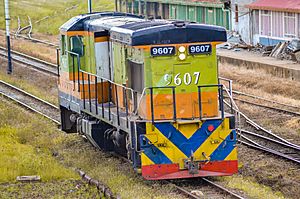Diesel locomotive facts for kids
A diesel locomotive is a special kind of locomotive (a train engine) that uses a diesel engine to move. Think of it like a big truck engine, but for a train! This powerful engine helps turn the train's wheels using a special system called a transmission.
Diesel locomotives are very popular all over the world. They are easy to use and very dependable. They can be stronger than older steam locomotives. Also, they don't need expensive power lines like electric locomotives do. This makes them useful in many places.
Contents
How Diesel Locomotives Work
Diesel locomotives use their engine to create power. This power then needs a way to get to the wheels. This is where the "transmission system" comes in. It's like the gearbox in a car, helping the engine's power reach the wheels. There are a few main ways this happens.
Mechanical Transmission
Some diesel locomotives use a mechanical system. This is similar to how a car works. The diesel engine connects directly to a gearbox. This gearbox then uses shafts or chains to spin the wheels. These types are often used for smaller trains or shunting (moving cars around a yard).
Electric Transmission
The most common type of diesel locomotive uses electric transmission. Here's how it works:
- The diesel engine runs a generator.
- This generator makes electricity.
- The electricity then powers electric motors.
- These electric motors are connected to the wheels, making the train move.
This system is very smooth and powerful, which is why it's used so much for big trains.
Hydraulic Transmission
Another way to transfer power is through a hydraulic system. This method uses special liquids under pressure.
- The diesel engine powers a hydraulic pump.
- This pump sends pressurized fluid to a hydraulic motor.
- The hydraulic motor then turns the train's wheels.
This system is also very effective and is used in some locomotives around the world.
Images for kids
-
The InterCity 125, the current confirmed record holder as the fastest diesel-powered train at 148 mph (238 km/h); is made up of two power cars, one at each end of a fixed formation of carriages; capable of 125 mph (201 km/h) in regular service.
-
Swiss & German co-production: world's first functional diesel–electric railcar 1914
-
Shunter of Nederlandse Spoorwegen from 1934, in modern livery
-
A British Rail Class 03 diesel–mechanical shunter with a jackshaft under the cab.
-
The EMD F40PH (left) and MPI MPXpress-series MP36PH-3S (right) locomotives coupled together by Metra use diesel–electric transmission.
-
MLW model S-3 produced in 1957 for the CPR adhering to designs by ALCO.
-
Metro-North's GE Genesis P32AC-DM electro-diesel locomotive can also operate off of third-rail electrification.
-
A Henschel (Germany) diesel–hydraulic locomotive in Medan, North Sumatra
-
British Rail diesel–hydraulic locomotives: Class 52 "Western", Class 42 "Warship" and Class 35 "Hymek"
-
A Canadian National Railway train showing the placement of the headlight and ditch lights on the locomotive.
See also
 In Spanish: Locomotora diésel para niños
In Spanish: Locomotora diésel para niños


































